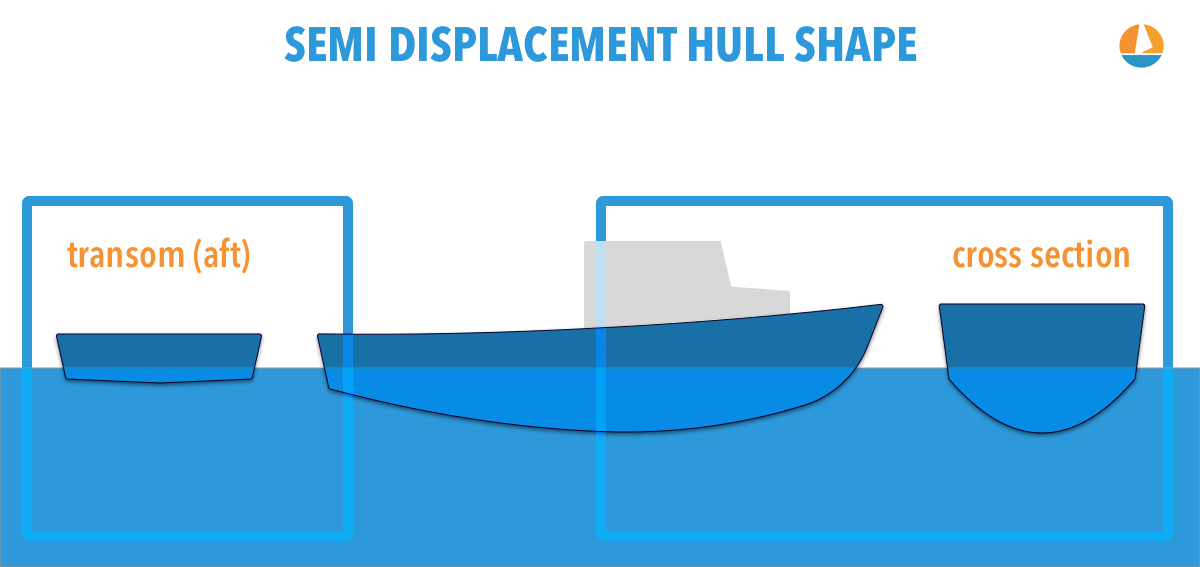Semi-Displacement Hulls Explained (Illustrated Guide)
If you want to know exactly what a semi-displacement hull is, this article is right for you. Here, I explain simply what it is, how it works, and why it's different from other hulls.
What is a semi-displacement hull? A semi-displacement hull is a hull design that combines features of the displacement and planing hull. It displaces water at low speeds but is able to generate lift at cruising speed. It is more stable than planing hulls, and faster than displacement hulls. It planes at lower speeds than regular planing hulls.
Generally, you'll find this type of hull on motor cruisers, trawlers, and the likes. Sailboats don't really come in this flavor, and I'll explain why below.

On this page:
Semi-Displacement Hulls Explained
A semi-displacement hull is a perfect hybrid between displacement hulls and planing hulls. It's the perfect medium speed range hull design. It is also called the semi-planing hull. To summarize briefly:
- A displacement hull lies inside the water, and displaces it as it moves. It holds up the boat using buoyancy.
- A planing hull lies on top of the water as it moves and holds up the boat using lift. This is called planing.
- A semi-displacement hull displaces water at low speeds, but is able to semi-plane at cruising speeds.
All three of these hull types come with their own unique advantages and disadvantages:
- The displacement hull is efficient and very dependable in rough waters.
- The planing hull is extremely fast and agile.
The semi-displacement hull is a bit of both. It's seaworthy and can be relied upon in rough waters, but at the same time, it's a lot faster than displacement hulls. Semi-displacement hulls are perfect for boats that need to be steady and seaworthy but fast at the same time.
Design Features

Hull Shape
The most important thing to understand is that generally, planing hulls are fine and flat aft (in the back), and displacement hulls are bulky and round. The semi-displacement hull combines these two design features. It is flat aft but gets bulkier towards the front. The bow (the front), has more of a wedge shape to it, like a Deep-V. The bow has to be able to displace water and lift at the same time. That's why the quality of the design is really important with these boats.
From the front, it looks like a sailboat, from the back, it looks like a powerboat.
Semi-Plane
The hull shape allows it to semi-plane. Planing simply means it's riding its own bow wave, lifting it out of the water. Planing is a great way to add speed, but it decreases stability.
Weight
The semi-displacement hull is heavier than a planing hull but lighter than a displacement hull. Because of its weight, it can't generate enough lift to fully plane. But because of its weight, it's also a lot more stable in rough waters.
How Does a Semi-Displacement Hull Work?
So now we understand the different features of this hull type, let's see how it comes together. At low speeds, the hull acts as a displacement hull, cutting through the water instead of riding on top of it. This makes it stable and reliable in waves. Its weight and keel make sure it handles well in choppy waves and rough weather, which is why it is a great design for coastal cruisers and trawlers and the likes.
At high speeds, the hull acts as a planing hull, riding on top of the water. This makes it a lot faster. Its flat back allows it to plane, as this will lift the front out of the water (but only partially). At the same time, the design of the bow helps it to climb out of the water. Between 12 - 16 knots (cruising speed), the semi-displacement hull will start climbing its own wave, generating lift. This reduces drag (water resistance). This adds a lot to its top speed. Roughly anywhere between 5 - 10 knots. That's a lot.
The semi planes at lower speeds than planing hulls though. This is great because most semis aren't that fast. The reason? The center of gravity is farther forward than planing boats1.
Maximum Hull Speed
The reason the semi-displacement hull is so much faster is that it's able to climb its own bow wave. Regular displacement hulls can't do this. This means they have an upper-speed limit, called the maximum hull speed. The maximum hull speed is a direct correlation between the length of the boat's waterline and the maximum speed.
To learn more about calculating maximum hull speed, and to view examples of different boat lengths and their upper limit, please check out my previous article here.
Semi-Displacement Hull Advantages
- faster at cruising speed
- can outrun storms thanks to speed
- larger range
- excellent rough-water boats
- are able to cross oceans
- shallower draft
Semi-Displacement Hull Disadvantages
- less efficient at low speeds than a displacement hull
- uses a lot of fuel at lower speeds
- a bit less comfortable than a displacement hull
- less storage due to flat aft and fine bow
- not as fast as planing hulls
Differences Between the Hull Types
Difference between semi-displacement hulls and displacement hulls
Semi-displacement hulls:
- have finer bow entry
- are flatter aft
- can generate lift, making it faster
- can outrun storms because of their speeds
- have less storage due to flat aft and fine bow
To learn more about displacement hulls, I recommend reading my full guide on it. It explains the pros and cons of displacement hulls.
Difference between semi-displacement hulls and planing hulls
Semi-displacement hulls:
- are narrower than planing hulls
- have a deeper and narrower hull forward, more like a deep V
- are not as fast as planing hulls
- are a lot steadier than planing hulls
- vessels weight is still supported by buoyancy
- are able to cross oceans
Yes, that's right. You can cross oceans with a semi-displacement hull. With a planing hull, that's not recommended. However, for those types of journeys, I'd still pick a full displacement hull over a semi every day of the week.
For examples of the most common hull types, please read my Illustrated Guide to Boat Hull Types here.
Who Might Like This Type of Hull?
If you want to have a comfortable ride, even in moderate to heavy chop, and want to have a reliable boat that also has some speed up its sleeve, this is a great hull design for you. With pretty decent speeds, often anywhere up to 20 - 30 knots, this hull can has plenty of thrill to it, while at the same time being comfortable and reliable. It's perhaps one of the most versatile hull designs out there. In my opinion, it offers the perfect fast-paced family cruiser for people who live near the coast and want to take her out for a bluewater spin.
Sailboats with Semi-Displacement Hulls
I haven't heard of any sailboats - monohulls - that have semi-displacement hulls. (If you have, please let me know in the comments below.) I think the reason is simply that sailboats can't deliver the power necessary to generate any meaningful lift. Cruising speed for most semi-displacement boats is roughly 15 - 20 knots - that's when lift is generated and it starts to semi-plane. Monohulls can't get up to that speed.
Catamarans can. There are cats out there with wide and flat aft hull sections, enabling them to get into a semi-plane. This is one of the reasons why cats are so much faster than monohulls.
Examples of Boats with Semi-Displacement Hulls
The most famous semi-displacement boat type is the Maine Lobster boat. Other boats that use semi-displacement are trawlers and motor cruisers.

Footnotes
Did you find the answer to your specific question?
👍 55 👎 6

Comments
DaveK
Thank you for a well formed explanation—assuming you’re correct. My wife and I are looking at boating as a retirement plan. She asked what the difference is between hull types. I can send her your link.
Stay safe and healthy!
Tom
Thank You for an excellent education, I learned much from your article. Is there a chance ou may provide your comments/comparison of the Majesty 140 and theh Benetti Diamond 145? I would so much appreciate your commentary. Most Appreciated !
David
MacGregor 26M is a semi displacement sail boat :-)
James
The MacGregor 26X sailboat is also a semi-displacement hull. Factory specs suggest 24 knot top speed under sail or with a 40 hp outboard motor. I have not reached those speeds under sail … more like 14 to 16 knots.
Jack
Thank you so much I understand the different types of hulls so much better!
robert salverda
Hi Shawn, I once owned a Lancer 39.5 foot sailboat. It had two Perkins 4-254 85 h.p engines in it. At full throttle it could actually plane, defying all the rules of a displacement hull, so I am assuming it must have had a semi-displacement hull.
Leave a comment